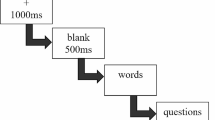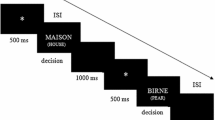Abstract
To investigate the influence of L2 proficiency and syntactic similarity on English passive sentence processing, the present ERP study asked 40 late Chinese-English bilinguals (27 females and 13 males, mean age = 23.88) with high or intermediate L2 proficiency to read the sentences carefully and to indicate for each sentence whether or not it was correct. Sentences were classified into literal translation sentences with the similar structure between the two languages and free translation sentences with the different structure. Behavioral data showed: shorter reaction times and higher accuracy rates occurred in the high-proficient group than those in the intermediate-proficient group; shorter reaction times and higher accuracy rates were observed in literal translation sentences than those in free translation sentences. ERP results showed literal translation sentences elicited an enhanced P200 and P600 while free translation sentences elicited a larger N400. The high-proficient group showed a larger P600 in syntactic violations and double violations while the intermediate-proficient group evoked an enhanced N400 in semantic violations and double violations. Literal translation sentences caused a larger P200 while free translation sentences elicited more negative-going N400. Behavioral and ERP data revealed the influence of L2 proficiency and syntactic similarity on L2 sentence processing, and L2 proficiency played a predominate role.




Similar content being viewed by others
References
Ainsworth-Darnell, K., Shuman, H., & Boland, J. (1998). Dissociating brain responses to syntactic and semantic anomalies: Evidence from event-related potentials. Journal of Memory and Language, 38, 112–130.
Ardal, S., Donald, M. W., Meuter, R., et al. (1990). Brain responses to semantic incongruity in bilinguals. Brain and Language, 39(2), 187–205.
Birdsong, D., & Molis, M. (2001). On the evidence for maturational constraints in second-language acquisition. Journal of Memory and Language, 44(2), 235–249.
Chen, L., Shu, H., Zhao, L. J., et al. (2007). ERP signatures of subject-verb agreement in L2 learning. Bilingualism, Language and Cognition, 10, 161–174.
Clahsen, H., & Felser, C. (2006a). Grammatical processing in language learners. Applied Psycholinguist, 27(1), 3–42.
Clahsen, H., & Felser, C. (2006b). How native-like is non-native language processing? Trends in Cognitive Sciences, 10, 564–570.
Coulson, S., King, J. W., & Kutas, M. (1998). ERPs and domain specificity: Beating a straw horse. Language and Cognitive Processes, 13(6), 653–672.
Dussias, P. E., & Cramer Scaltz, T. R. (2008). Spanish-English L2 speakers’ use of subcategorization bias information in the resolution of temporary ambiguity during second language reading. Acta Psychologia, 128(3), 501–503.
Flege, J. E., & MacKay, I. R. A. (2004). Perceiving vowels in a second language. Studies in Second Language Acquisition, 26(1), 1–34.
Friederici, A. D. (2002). Towards a neural basis of auditory sentence processing. Trends in Cognitive Sciences, 6(2), 78–84.
Friederici, A. D., Hahne, A., & Saddy, D. (2002). Distinct neurophysiological patterns reflecting aspects of syntactic complexity and syntactic repair. Journal of Psycholinguistic Research, 31(1), 45–63.
Friederici, A. D., et al. (1996). Temporal structure of syntactic processing: Early and late event-related potential effects. Journal of Experimental Psychology: Learning, Memory, and Cognition, 22, 1219–1248.
Gunter, T. C., Friederici, A. D., & Hahne, A. (1999). Brain responses during sentence reading: Visual input affects central processes. NeuroReport, 10, 3175–3178.
Hagoort, P., Brown, C., & Groothusen, J. (1993). The syntactic positive shift (SPS) as an ERP measure of syntactic processing. Language and Cognitive Processes, 8, 439–483.
Hahne, A. (2001). What’s different in second language processing? Evident from event-related brain potentials. Journal of Psycholinguistic Research, 30, 251–266.
Hahne, A., & Friederici, A. D. (1999). Electrophysiological evidence for two steps in syntactic analysis: Early automatic and late controlled processes. Journal of Cognitive Neuroscience, 11, 194–205.
Hahne, A., & Friederici, A. D. (2001). Processing a second language: Late learners’ comprehension mechanisms as revealed by event-related brain potentials. Bilingualism: Language and Cognition, 4, 123–141.
Hahne, A., Mueller, J. L., & Clahsen, H. (2006). Morphological processing in a second language: Behavioral and event-related brain potential evidence for storage and decomposition. Journal of Cognitive Neuroscience, 18, 121–134.
Hawkins, R. (2001). Second language syntax. Malden: Blackwell Publishers.
Hopp, H. (2006). Syntactic features and reanalysis in near-native processing. Second language research, 22(3), 369–397.
Jiang, N. (2007). Selective integration of linguistic knowledge in adult second language learning. Language Learning, 57(1), 1–33.
Johnson, J. S., & Newport, E. L. (1989). Critical period effects in second language learning: The influence of maturational state on the acquisition of English as a second language. Cognitive Psychology, 21, 60–99.
Kaan, E., & Swaab, T. Y. (2003). Repair, revision, and complexity in syntactic analysis: An electrophysiological differentiation. Journal of Cognitive Neuroscience, 5, 335–344.
King, J. W., & Kutas, M. (1998). Neural plasticity in the dynamics of human visual word recognition. Neuroscience Letters, 244(2), 61–64.
Kotz, S. A., Holcomb, P. J., & Osterhout, L. (2008). ERPs reveal comparable syntactic sentence processing in early bilinguals and monolinguals. Acta Psychologica, 128(3), 514–527.
Kutas, M., & Kluender, R. (1994). What is who violating? A reconsideration of linguistic violations in light of event-related brain potentials. In H. J. Heinze, T. F. Münte, & G. R. Mangun (Eds.), Cognitive electrophysiology: Basic and clinical applications. Boston: Birkhäuser.
Li, R. B., Peng, D.-L., & Guo, T.-M. (2003). A study on Chinese and English semantic access with ERP technology. Acta Psychologica Sinica, 35(3), 309–316.
Luck, S. J. (2005). An introduction to the event-related potential technique. Cambridge, MA: MIT Press.
McDonald, J. L. (2000). Grammaticality judgments in a second language: Influences of age of acquisition and native language. Applied Psycholinguistics, 21(3), 395–423.
Münte, T. F., Heinze, H., & Magnum, G. (1993). Dissociation of brain activity related to syntactic and semantic aspects of language. Journal of Cognitive Neuroscience, 5, 335–344.
Natalie, A. P., Denise, K., Mercier, J., et al. (2006). ERP measures of auditory word repetition and translation priming in bilinguals. Brain Research, 1125(1), 116–131.
Neville, H. J., Nicol, J., Barss, A., Forster, K., & Garrett, M. F. (1991). Syntactically based sentence processing classes: Evidence from event-related brain potentials. Journal of Cognitive Neuroscience, 3, 151–165.
Ojima, S., Nakata, H., & Kakigi, R. (2005). An ERP study of second language learning after childhood: Effects of proficiency. Journal of Cognitive Neuroscience, 17(8), 1212–1228.
Osterhout, L. (1997). On the brain response to syntactic anomalies: Manipulations of word position and word class reveal individual differences. Brain and Language, 59(3), 494–522.
Osterhout, L., & Holcomb, P. J. (1992). Event-related potentials elicited by syntactic anomaly. Journal of Memory and Language, 2, 785–806.
Osterhout, L., & Holcomb, P. J. (1993). Event-related potentials and syntactic anomaly: Evidence of anomaly detection during the perception of continuous speech. Language and Cognitive Processes, 8, 413–438.
Osterhout, L., Holcomb, P. J., & Swinney, D. A. (1994). Brain potentials elicited by garden-path sentences: Evidence of the application of verb information during parsing. Journal of Experimental Psychology: Learning, Memory, and Cognition, 20(4), 786–803.
Osterhout, L., & Mobley, L. A. (1995). Event-related potentials elicited by failure to agree. Journal of Memory and Language, 34, 739–773.
Osterhout, L., & Nicol, J. (1999). On the distinctiveness, independence, and time course of the brain responses to syntactic and semantic anomalies. Language and Cognitive Processes, 14(3), 283–317.
Pan, W.-G. (2004). Comparative guidelines of Chinese and English. Beijing: Beijing Language University Press.
Perani, D., Paulesu, E., Sebastian-Galles, N., Dupoux, E., Dehaene, S., & Bettinardi, V. (1998). The bilingual brain: Proficiency and age of acquisition of the second language. Brain, 121(10), 1841–1852.
Roberts, L., & Felser, C. (2011). Plausibility and recovery from garden paths in second language sentence processing. Applied Psycholinguistics, 32(2), 299–331.
Roberts, L., & Meyer, A. (2012). Individual differences in second language sentence processing. Language Learning, 62(2), 1–4.
Rösler, F. (1993). Event-related brain potentials while encountering semantic and syntactic constraint anomalies. Journal of Cognitive Neuroscience, 5, 345–362.
Rossi, S., Gugler, M. F., Friederici, A. D., & Hahne, A. (2006). The impact of proficiency on syntactic second-language processing of German and Italian: Evidence form event-related potentials. Journal of Cognitive Neuroscience, 18, 2030–2048.
Sabourin, L. D., & Stowe, L. A. (2008). Second language processing: When are first and second languages processed similarly? Second Language Research, 24(3), 397–430.
Sanders, L. D., & Neville, H. J. (2003). An ERP study of continuous speech processing: II. Segmentation, semantics, and syntax in non-native speakers. Cognitive Brain Research, 15(3), 214–227.
Semlitsch, H. V., Anderer, P., Schuster, P., & Presslich, O. (1986). A solution for reliable and valid reduction of ocular artifacts, applied to the P300 ERP. Psychophysiology, 23, 695–703.
Steinhauer, K., White, E. J., Cornell, & Drury, J. E. (2009). Temporal dynamics of second language acquisition: Evidence from event-related brain potentials. Second Language Research, 25(1), 13–41.
Tokowicz, N., & MacWhinney, B. (2005). Implicit and Explicit measures of sensitivity to violations in second language grammar: An event-related potential investigation. Studies in Second Language Acquisition, 27, 173–204.
Tolentino, L. C., & Tokowicz, N. (2011). Across languages, space, and time: A review of the role of cross-language similarity in L2 (morpho)syntactic processing as revealed by fMRI and ERP methods. Studies in Second Language Acquisition, 33(1), 91–125.
VanBerkum, J. A., Hagoort, P., & Brown, C. M. (1999). Semantic integration in sentences and discourse: Evidence from the N400. Journal of Cognitive Neuroscience, 11(6), 657–671.
Weber-Fox, C. M., & Neville, H. J. (1996). Maturational constraints on functional specializations for language processing: ERP and behavioral evidence in bilingual speakers. Journal of Cognitive Neuroscience, 8, 231–256.
Weber-Fox, C. M., & Neville, H. J. (2001). Sensitive periods differentiate processing of open and closed class words: An ERP study of bilinguals. Journal of Speech, Language, and Hearing Research, 44, 1338–1353.
White, L. (2003). Second language acquisition and Universal Grammar. Cambridge: Cambridge University Press.
Williams, J. N. (2006). Incremental interpretation in second language sentence processing. Bilinguialism: Language and Cognition, 9(1), 71–81.
Xiong, X.-L., & Wang, Z.-J. (2003). The cognitive interpretation of passive sentences. Foreign Language Teaching and Research, 35(3), 195–199.
Ylinen, S., Shestakova, A., Alku, P., & Huotilainen, M. (2005). The perception of phonological quantity based on durational cues by native speakers, second-language users and non speakers of Finnish. Language and Speech, 48(3), 313–338.
Acknowledgments
Youth project of China national natural science fund “the Moderating mechanism of Late Chinese-English Second Language Learners’ Syntactic Processing: behavior and ERP research” (31300928).
Author information
Authors and Affiliations
Corresponding author
Rights and permissions
About this article
Cite this article
Chang, X., Wang, P. Influence of Second Language Proficiency and Syntactic Structure Similarities on the Sensitivity and Processing of English Passive Sentence in Late Chinese-English Bilinguists: An ERP Study. J Psycholinguist Res 45, 85–101 (2016). https://doi.org/10.1007/s10936-014-9319-1
Published:
Issue Date:
DOI: https://doi.org/10.1007/s10936-014-9319-1




